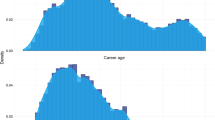Abstract
The departmental characteristics associated with the average duration of doctoral study were studied in a national data set collected by the National Research Council. The biological, mathematical and physical sciences, and engineering had relatively short medians and narrow ranges across departments, and the humanities had larger medians and wider ranges. The pattern of results associated with the duration of doctoral study suggested the importance of departmental emphases on scholarly careers and the resources to implement those emphases. The patterns of results varied by general area, and by specific discipline, suggesting the need for detailed analysis within disciplines.
Similar content being viewed by others
References
Adelman, C. (1985).The Standardized Test Scores of College Graduates 1964–1982. Washington, DC: Office of Educational Research and Improvement, USOE.
Baird, L. L. (in press). The melancholy of anatomy: The personal and professional development of graduate and professional school students. In J. C. Smart (ed.),Higher Education: Handbook of Theory and Research, vol. 6. New York: Agathon.
Berelson, B. (1960).Graduate Education in the United States. New York: McGraw-Hill.
Brenneman, D. (1975).Graduate School Adjustments to the “New Depression” in Higher Education. Washington, DC: National Academy of Sciences.
Centra, J. A. (1974).Men, Women, and the Doctorate. Princeton, NJ: Educational Testing Service.
Duggan, J. (1989). On time to the doctorate. Paper presented at 29th Annual Meeting of the Council of Graduate Schools. Washington, DC, November.
Evangelauf, J. (1989, March 15). Lengthening of time to earn a doctorate causes concern.Chronicle of Higher Education 35: 1ff.
Girves, J. E., and Wemmerus, V. (1988). Developing models of graduate student degree progress.Journal of Higher Education 59: 163–189.
Griggs, C. M. (1965). (1965).Graduate Education. New York: Center for Applied Research in Education.
Gunn, C. S., and Sanford, T. R. (1988). Doctoral student retention.College and University 63: 374–382.
Harmon, L. R., and Soldy, H. C. (1963).Doctorate Production in United States Universities, 1920–1962: Publication No. 1142. Washington, DC: National Academy of Sciences, National Research Council.
Hartnett, R. T. (1987). Has there been a graduate student “brain drain” in the arts and sciences?Journal of Higher Education 58: 562–585.
Hauptman, A. M. (1986).Students in Graduate and Professional Education: What We Know and Need to Know. Washington, DC: Association of American Universities.
Heiss, A. M. (1970).Challenges to Graduate Schools. San Francisco: Jossey-Bass.
Hoaglin, D. C., Mosteller, F., and Tukey, J. (1983).Understanding Robust and Exploratory Data Analysis. New York: John Wiley & Sons, Inc.
Jones, L. V., Lindsey, G., and Coggeshell, P. E. (1982).An Assessment of Research-Doctorate Programs in the United States, 5 vols. Washington, DC: National Academy Press.
National Research Council (1989).Summary Report 1987: Doctorate Recipients from United States Universities. Washington, DC: National Research Council.
Nerad, M., and Cerny, J. (1989). From facts to actions: Expanding the educational role of the graduate division. Paper presented at 14th Annual Meeting of the Association for the Study of Higher Education, Atlanta, GA, November.
Roose, K. S., and Anderson, C. J. (1970).A Rating of Graduate Programs. Washington, DC: American Council on Education.
Smith, B. L. R. (ed.) (1985).The State of Graduate Education. Washington, DC: Brookings Institution.
Snyder, R. G. (1985). Some indicators of the condition of graduate education in the sciences. In B. L. R. Snyder (ed.),The State of Graduate Education. Washington, DC: Brookings Institution.
Solmon, L. C. (1976).Male and Female Graduate Students. New York: Praeger.
Tuchman, H. P., Coyle, S., and Bae, Y. (1989). The lengthening time to the doctorate degree.Research in Higher Education 30: 503–516.
Wilson, K. M. (1965).Of Time and the Doctorate: Report of an Inquiry into the Duration of Doctoral Study. Atlanta: Southern Regional Education Board.
Author information
Authors and Affiliations
Rights and permissions
About this article
Cite this article
Baird, L.L. Disciplines and doctorates: The relationships between orogram characteristics and the duration of doctoral study. Res High Educ 31, 369–385 (1990). https://doi.org/10.1007/BF00992273
Received:
Issue Date:
DOI: https://doi.org/10.1007/BF00992273




